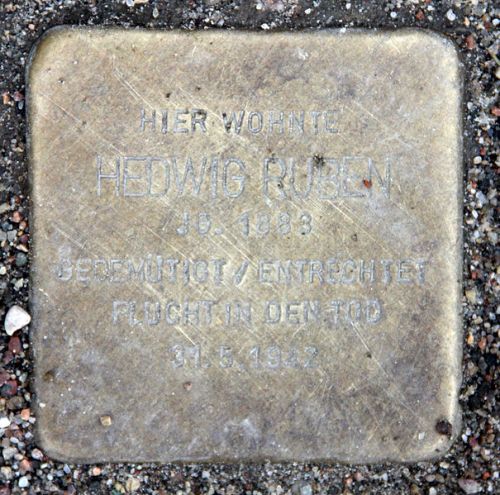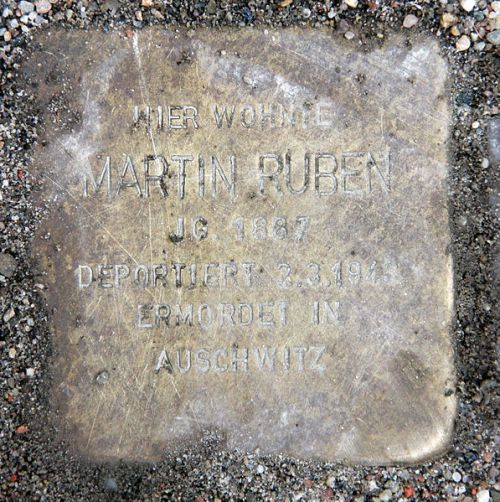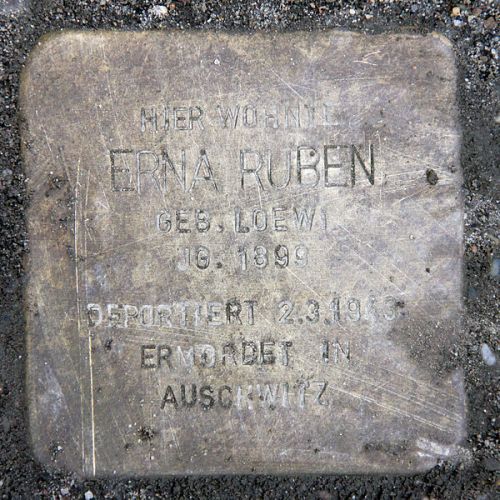Stumbling Stones Dahlmannstraße 10
These small, brass memorial plaques (Stolpersteine or stumbling stones) commemorate:
* Hedwig Ruben, born 1883, humiliated / deprived of rights, killed herself 31 May 1942.
* Martin Ruben, born 1887, deported 2 March 1943, murdered in Auschwitz.
* Erna Ruben née Loewi, born 1899, deported 2 March 1943, murdered in Auschwitz.
Erna Loewi’s sister Anita escaped to England in 1933. After their father died, Erna lived with her widowed mother in another Berlin location on Sächsische Straße. The mother managed to go to England to live with her daughter. But Erna Loewi and her new husband, Martin Ruben, did not succeed in getting out of Germany. After their marriage in February 1942, they moved to Dahlmannstraße 10, where he had been registered as a merchant since 1935. All the Loewi belongings remained at Sächsische Strasse, which had been turned into a Jewish house. The belongings were then confiscated by the Gestapo. Erna and Martin Rubin officially signed over their assets on 15 February 1943. Two weeks later, they were deported with over 1,750 people on the 32nd transport from Berlin to the East and were murdered in Auschwitz.
Hedwig Ruben lived with her older brother Martin at this Dahlmannstraße address since the mid-1930s. Erna Ruben joined them in February 1942. Four months later, in May, Hedwig received her deportation notice. It was too much after the years of persecution, and she took her own life. The process of confiscating her property was clearly documented by the Nazis, and some of the disturbing details are described in Bezirksamt-Charlottenburg-Wilmersdorf: Dahlmanstr. 10.
"Stolpersteine" is an art project for Europe by Gunter Demnig to commemorate victims of National Socialism (Nazism). Stolpersteine (stumbling stones) are small, 10x10cm brass plaques placed in the pavement in front of the last voluntary residence of (mostly Jewish) victims who were murdered by the Nazis. Each plaque is engraved with the victim’s name, date of birth, and place (mostly a concentration camp) and date of death. By doing this, Gunter Demnig gives an individual memorial to each victim. One stone, one name, one person. He cites the Talmud: "A human being is forgotten only when his or her name is forgotten."
Do you have more information about this location? Inform us!
Source
- Text: Fedor de Vries & Anne Palmer
- Photos: OTFW, Berlin (1), OTFW, Berlin (2), OTFW, Berlin (3)
- Stolpersteine in Berlin: Martin Ruben
- Bezirksamt-Charlottenburg-Wilmersdorf: Stolpersteine Dahlmanstr. 10.
- Stolpersteine.eu
Nearby
Museum
Point of interest
- Salon Kitty - Berlin
- Reichs Militär Gericht - Berlin
- Reich Eagle Ministry of Finance Berlin - Berlin
Monument
- Memorial Klara Grüger - Berlin-Charlottenburg
- Memorial Jewish Musicschool - Berlin-Charlottenburg
- Memorial Moriz Seeler - Berlin-Wilmersdorf
Cemetery
- German War Graves Friedhof Wilmersdorf - Berlin-Wilmersdorf
- Grave Arthur Axmann - Berlin-Wilmersdorf
- Luisenfriedhof II - Berlin
Remembrance Stone
- Stumbling Stones Dahlmannstraße 11 - Berlin-Charlottenburg
- Stumbling Stones Dahlmannstraße 24 - Berlin-Charlottenburg
- Stumbling Stones Sybelstraße 18 - Berlin-Charlottenburg






